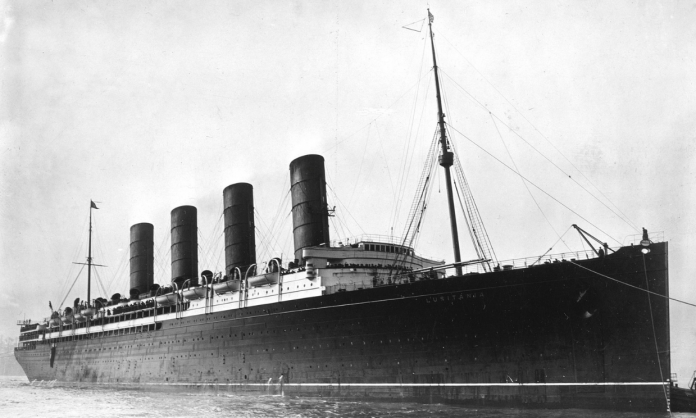By C.A. Tremayne
The course of history has been known to change irrevocably in the space of a single day, and one of these days took place in May 1915 off the Old Head of Kinsale in County Cork when the cry went out on board the widely touted to be unsinkable British Cunard passenger liner Lusitania. Torpedo…torpedo on starboard side, with no time to take evasive action before the underwater missile found its mark.
What followed was eighteen minutes of fear for the 1,198 people who were on board, 124 of them American. It is this last figure that was to change the course of history, for the death of the Americans precipitated the entry of the United States into World War One, and ultimately ensured victory for the Allies.
With the First World War at its most vicious the Germans decided to carry out the unthinkable and attack not only British warships but passenger ships as well. In fact the order was given from the German high command that any ship they came across was fair game.
Not aware of this at the time, Captain Turner of the Lusitania carried on, in fact he was some eleven miles off the Irish coast and when he received the warning that U-Boats were operating in his area immediately doubled the watch and ordered that the davits were swung put in order to ease any launch of lifeboats that might be needed. He also ordered all lights lowered and made an entry in his personal log that he expected a Royal Navy escort would be sent out to escort them into Cobh; the expected escort never arrived.
Just thirty minutes after he received the warning his ship came under the sights of Captain Walther Schwieger who was in the process of heading for home after a somewhat successful mission operating right under the noses of the British Navy between Fastnet and Waterford. Sighting the four funnels of the Lusitania as it steamed along the Irish Coast towards the Old Head of Kinsale and Queenstown (now Cobh) Schwieger wasted no time ordering his men to prepare to attack, and at the same time set about bringing his boat into the optimal firing position.
Once all this had been achieved which was a matter of minutes, he gave the order to fire. The torpedo shot towards the liner at about 40 knots and struck the ship on the starboard side. Just eighteen minutes later she had sank, going down fast, in fact so fast did she go down that a local family called Henderson who were out walking their dog could not believe it. In a statement the family later made they stated that one minute they were admiring the ship as she steamed along the next second they stated that there was a faint plume of smoke which seemed to rise above the ship then she was gone.
There are many unanswered questions about the sinking of this passenger ship, and the first of these questions must be, did Sir Winston Churchill set the whole thing up in order to encourage the USA to join the fight against the Germans, there is also the question as to weather or not the ship was painted in camouflage colours at the time of her sinking, and was she in fact carrying arms to Britain as part of the war effort? Soon after the sinking the Germans issued a statement stating this as fact, then there is the fact that the ship had sent out distress signals as soon as she was hit.
These were picked up by the British Destroyers which were based at Cobh at the time, and in fact they were in the process of getting under way in order to give assistance when the order came from the Admiralty not to go to the rescue. The reason given for this was that there might have been more German U-Boats in the vicinity. At the time nobody cared to ask for more details concerning this fact; after all Britain was at war with the Germans so enemy ships and U-Boats should have come as no surprise. The rescue fell to a fleet of small boats totally manned by Irish fishermen and a small number of local yachtsmen who without any fear of German U-Boats put out to sea in order to do what they could.
The fact remains that the building of the ship was subsidized by the Admiralty under a secret agreement, details of which have never been released, the ship was over 670 feet long, could carry 2,300 passengers in total luxury and a crew of 900, she could travel at 25 knots with ease, and during the building process brackets had been fitted making her capable of mounting twelve six-inch guns at a moment’s notice.
Today, there stands a beautiful memorial in Cobh in honour of the brave Irish fishermen who put to sea in their small boats in order to try and save the lives of as many passengers as they could. But with only eighteen minutes before the great ship went under time was not on their side.
There was a song going around at that time and the first verse goes as follows:
‘The good ship Lusitania for ten years sailed the foam,
And n’er before was there a loss of human life aboard,
Till along came the cruel Germans,
And lay for her unseen,
They shattered her to pieces,
With their cursed submarine.’








